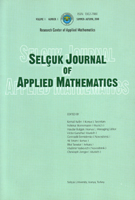|

Selšuk Journal
of
Applied Mathematics
Summer-Autumn, 2002
Volume 3
Number 2
Research Center
of
Applied Mathematics
|
|
SJAM
Summer-Autumn 2002, Volume 3 - Number 2
|
|
Locally
exact smooth
reconstruction of
lines, circles,
planes, spheres,
cylinders and
cones by
blending successive
circular
interpolants |
|
Richard Liska1,
Mikhail Shashkov2 and Blair Swartz2 |
|
1 Faculty of
Nuclear Sciences and Physical Engineering, Czech Technical
University in
Prague,
Břehovß 7, 115 19 Prague 1, Czech Republic;
email:
liska@siduri.fjfi.cvut.cz
2 Group T-7, Los Alamos National Laboratory, Los Alamos,
NM 87545, USA;
email:
shashkov@lanl.gov
email:
bks@lanl.gov
Received: July 16, 2002
|
|
Summary
G1-smooth
curves and
surfaces are
developed to
span a given
logically cuboid
distribution of
nodes. Given
appropriate data, they
locally reconstruct
the curves
and surfaces
of spherical or
cylindrical
coordinates. Thus,
if a set of nodes
consists of a
contiguous subset of a
tensor product
grid of points
associated with
a (possibly non-uniform)
set of coordinate
values of some
rectangular,
cylindrical, or
spherical
coordinate system;
then the
appropriate
coordinate curves (linear
or circular
segments) and
coordinate surfaces
(segments of planes,
cylinders, spheres
and cones)
that interpolate
the subset
are reconstructed
exactly. The
underlying
construction uses
four successive
nodes to
define a curve
spanning the
middle pair as
follows: One
interpolates each
of the two
successive triples
of nodes with
the segment
of a circle or
straight line
going through
these three
points. Then
one blends
the two
segments
continuously between
the middle
pair of nodes.
The blend is
relatively linear
in terms of arc-length
along each
segment. The
union of such
successive curve-sections
forms a G1
curve. Wire-frames
of such curves
define cell edges.
Similar
intermediate curvilinear
interpolation of
the wires
defines cell
faces, and
their union
defines G1 coordinate-like
surfaces. The
surface generated
depends on the
direction one
interpolates the
wires. If
the nodes
are a tensor
product grid
associated with
a sufficiently
smooth reference
coordinate system,
then the
cell edges (and
probably also
the cell
faces) are
third-order
accurate. |
|
|
|
Key
words
smooth
reconstruction, line,
circle, plane,
sphere, cylinder,
cone, interpolation
|
|
2000 Mathematics
Subject
Classification : 65D15
|
|
Article
in PS format (2.35 Mb) |
Article
in ZIP format (492 Kb) |
|


